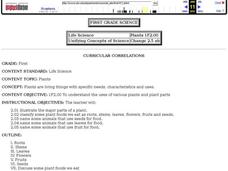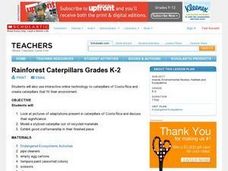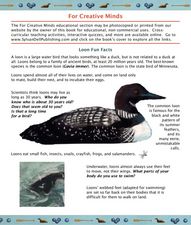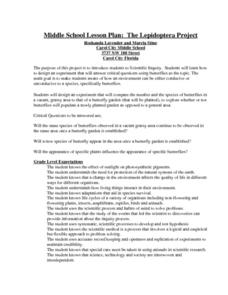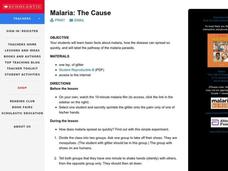Curated OER
Creature Features
Students examine why certain animals live in only specific places throughout the world. Using animals, they classify them based on their characteristics and identify their basic needs. They also observe and compare the life cycles of...
Curated OER
Plants
Learners illustrate the major parts of a plant, classify some plant foods we eat as roots, stems, leaves, flowers, fruits and seeds. They also name some animals that use seeds, leaves, and fruit for food.
Curated OER
How Hot is Too Hot?
Fifth graders use the scientific method to conduct experiments on the temperature effects on organisms. In this temperature effects on organisms lesson plan, 5th graders observe and record the hatching or the developing of organisms into...
Curated OER
The Life Cycle of the Butterfly
Second graders study the life cycle of a butterfly by observing metamorphosis taking place in a butterfly pavilion. Students illustrate their understandings of the body parts of a caterpillar and butterfly, as well as the life cycle,...
Curated OER
Rainforest Caterpillars Grades K-2
Learners are told that after they discuss and examine of rainforest caterpillars, they are going to create their own rainforest caterpillar based on the information they have studied. They are given the habitat scenarios on 3x5 cards.
Curated OER
School Yard Park/Ecosystem
Fifth graders observe and categorize different sections of a park and it's ecosystem. For this categorizing lesson plan, 5th graders collect different facets of nature from a nearby park (without disturbing the ecosystem). They map,...
Curated OER
School Yard Park/ Ecosystem
Fifth graders examine ecosystems in their schoolyard. In this nature and ecosystem lesson, 5th graders map their schoolyard into workable plots. They classify plants and animals found in the plot. They revisit their site every two weeks...
Curated OER
Symmetry that is Basic and Beautiful
Learners explore lines of symmetry. In this symmetry lesson, students divide and combine shapes along basic lines of symmetry. Learners explore symmetry in real life objects.
Curated OER
Fragments
In these sentence correction worksheets, students read the sentences and determine if the underlined portion contains a fragment error. Students select the choice that corrects the mistake.
Curated OER
Scientific Classification
In this scientific classification worksheet, students read about classification and the questions scientists ask in order to classify, then read about features of different classifications of animals. Worksheet is informational, no...
Curated OER
In My Backyard
In this backyard wildlife instructional activity, learners read and complete activities on 6 pages. Students make a mini book to read that pertains to common backyard wildlife. Learners read about signs of animal life and learn about...
Curated OER
Loon Fun Facts
Third graders learn about loon fun facts. In this loon lesson, 3rd graders read three pages of facts about loons and their habitats. They read Native American myths about loons and make a loon mask using the attached worksheets.
Curated OER
Pond Ecosystem Field Trip
Students investigate the environment by participating in a class trip. In this pond ecosystem lesson, students define a list of vocabulary terms associated with ponds such as invertebrate and metamorphosis. Students attend a field trip...
Curated OER
Struggle for Existence and Population Growth in Aphids
Students examine the population of aphids. They identify adaptations they have made for their environment. They make predictions, test their hypothesis and collect information that either proves or disproves their theory.
Curated OER
Making a Food Web and Learning About Ecosystems
Third graders examine the difference between a food web and food chain. They also examine the importance of the sun in a food web and food chain. Students understand what happens when you remove parts of the chain.
Curated OER
The Birds and the Bees, and the Flowers and the Trees
Learners examine the roles in which animals play in the pollination of plants. They recognize that flowers have male and female sexes. Students describe cross pollination and propose reasons for cross pollination through narration of a...
Curated OER
Survivor
Seventh graders investigate changes in the ecosystem within the school year. They see that ecosystems, communities, populations, and organisms are dynamic and change over time. They, in groups, collect data in quadrants in the fall,...
Curated OER
Animal Research and Report
Students research an animal that lives near them in their community. They observe and describe animals that live near them. They also include illustrations of the animal they are observing.
Curated OER
Do we Really Need Wild Nature
Students research challenges with which modern biotechnology confronts wild nature. Students collect articles that relate to biotechnology and the environment. Students prepare a collaborative answer to the question, "Do we really need...
Curated OER
The Lepidoptera Project
Students are introduced to Scientific Inquiry and discover how to design an experiment that answers critical questions using butterflies as the topic. They design experiments that compare the number of species of butterflies in a vacant,...
Curated OER
Malaria: The Cause
Students explore the basic facts about malaria. They study how the disease can spread so quickly and label the pathway of the malaria parasite.
Curated OER
Great River Bend Adventure
Students use their imagination. They discuss the 4 C's of teamwork: Concentration, Communications, Coomperation, and Consideration. Students discuss the safety guidelines of the project. They complete a rope maze. The group walks...
Curated OER
Ecosystems and Symbiotic Relationships
Students are told to create a community using words or pictures. They walk outside to an area in front of the school which has a strip of grass, ditch, and corn field. Students discuss the difference between an ecosystem and a...
Curated OER
Plant Reproduction
High schoolers identify the different parts and function of a flower's reproductive system. In this biology lesson, students explain how pollination works. They watch a video and practice labeling parts of both flower and leaf.

